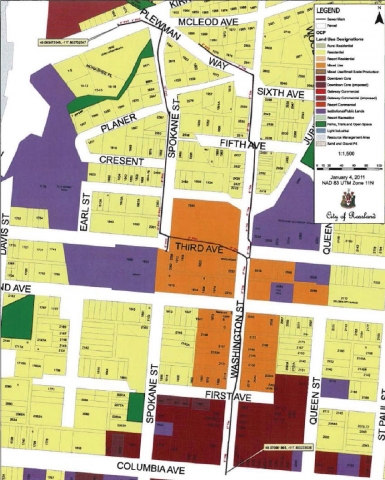Downtown Underground: a slightly elderly inventory of sewer, water, and drainage
The primary problem with the most recent asssessment of Rossland’s downtown water and sewer pipes is that the engineers never went underground. Still, two 2009 reports compiled with the help of city staff, maps, and previous assessments ranging in age from 1995-2008, provides plenty of reasons why they – perhaps – should.
What follows are essentially inventory notes from an above-ground review, not recommendations or financial quotes as the reports were classed “C,” meaning good enough for a rough cost projection for budget-planning purposes in the early stages of concept development of a project – the federal Treasury Board definition.
In February 2010, WSA Engineering provided the City with a review and rough estimate for work needed on and under Washington Street: water, sewer and storm drain. Perhaps not surprisingly in a city this old, the report uncovers issues with age, and a smattering of unknowns.
According to WSA, “the existing sanitary sewer system along Washington St. and Plewman Way consists of an old 200mm and 150mm vitrified clay (tile) main and tile services which require repairs and upgrades. . . . Many of the sanitary manholes are constructed of brick, are in poor condition, and should be replaced.”
On the “unknowns” sanitary sewer list, there is:
- “A main of unknown size coming under the building on the southeast corner of Washington St. and 1st Avenue”
- “A short main of unknown size and material that joins at the alley by house #2310 with no manhole. This main may service more than one dwelling.”
- “A short stub of 150mm tile main from the west with no apparent service connections joins at (the) manhole (at Jubilee and 3rd Ave).
- An “abandoned tile service from the west just north of (the) manhole (in the alley south of 2nd Ave. on Washington St.)”
- A number of missing manholes at system joints.
The report indicates there is no storm water system between 3rd and 6th Avenues on Washington St., continuing: “the catch basins are old, spaced too far apart, and are not located to effectively capture the storm runoff. There are no proper storm water manholes along Washington St. – with catch basins serving as manholes. There are no service connections from the commercial rooftops to the storm sewer. . . . (and) also a catch basin located at the southeast corner of the 2nd Avenue intersection, which is not effectively placed.”
Plewman Way catch basins are “few” and “ineffective.”
Washington Street’s sidewalks, curb and gutter, and road surface drainage get similar dismal reviews:
“Much of the sidewalk is in poor condition, and the curb and gutter does not adequately function in directing storm runoff to catch basins,” it reads. “The road surface along the entire stretch of Washington St. between Columbia St. and Plewman Way is not crowned properly to ensure adequate runoff drainage during storms. Storm water runoff flows down the roadway and is not adequately captured by the poorly located existing catch basins.”
WSA also assessed Columbia Avenue, between Monita and St. Paul streets, with the assistance of city staff, plans and ageing previous reports, noting that the domestic water system- mains, service connections, valves, and fire hydrants – “along Columbia Avenue is very old (some piping dating back to 1930) and in need of repairs and upgrades.”
“The City Public Works representative informed WSA that some sections of pipe along Columbia Avenue have greatly reduced capacity, due to internal corrosion and deposition, and that frequent repairs are required to fix leaks and ruptures.”
The report goes on to conclude that “the existing infrastructure (water mains, service connections, valves and hydrants) is in very poor condition and continuing the current approach of spot repairs to this system is not cost effective.” Pipe sizing is also considered an area of inadequacy.
Columbia Avenue’s sanitary sewer setup boasts:
- An abandoned 200mm pipe parallel to the main between Spokane and Washington streets.
- “Regular sanitary sewer issues at Clanseys Cappuccino, believed to be caused by sharing a service with the adjacent business.”
- 45 metres of pipe installed in 1988, followed by 30 meters of unknkown age, and then another 45 metres dating from 1988 between Cliff and Davis streets.
- Sporadic combinations of pipe in different compositions and sizes, including one section between Queen and St. Paul streets where 10 metres of blue brute pipe from 1985 is pushed through another 300mm vitrified clay pipe serving eight buildings.
- 30 metres of vitrified clay pipe in a rock tunnel between Washington and Queen streets that the report stresses should be replaced.
The Columbia Avenue storm water system “appears to be operating well,” though quirky pipe sizing and composition is again identified as an issue. The system consists of “various sizes of concrete, PVC, and vitrified clay pipe,” and some commercial roof drainage on may be connected to the sanitary sewer, rather than storm water, system, leading to unnecessary treatment volumes. But overall, “most of the existing storm sewer pipes along Columbia Avenue (though shallow) are functioning well and do not need to be replaced,” and the existing 33 catch basins along Columbia are doing the job “adequately,” though top-inlet basins should be upgraded to top-and-side inlet to increase storm water capture.
Overall, “WSA’s assessment of the City of Rossland’s infrastructure along Columbia Avenue indicates that, although some sections are in good condition, and appear to be functioning well, there are significant sections that need replacement or upgrading.”
The city has issued a request for qualifications to get an underground engineering assessment and up-to-date sense of cost, though infrastructure dorks are welcome to delve into these full reports – with recommendations and early costs – which are attached.


























